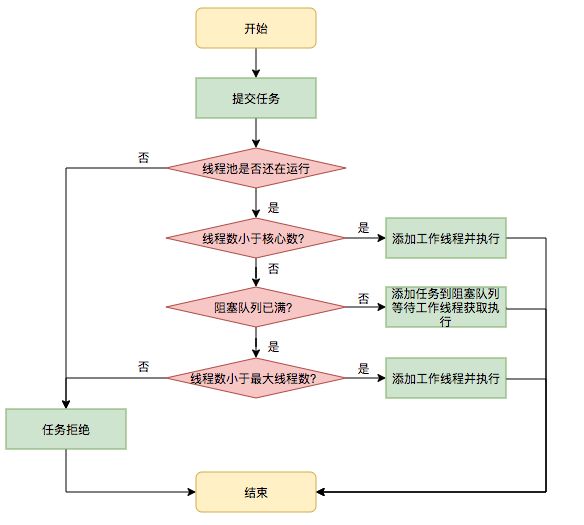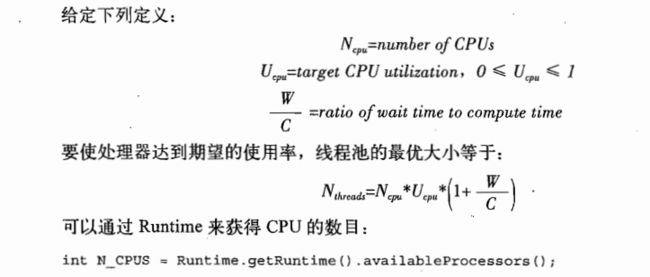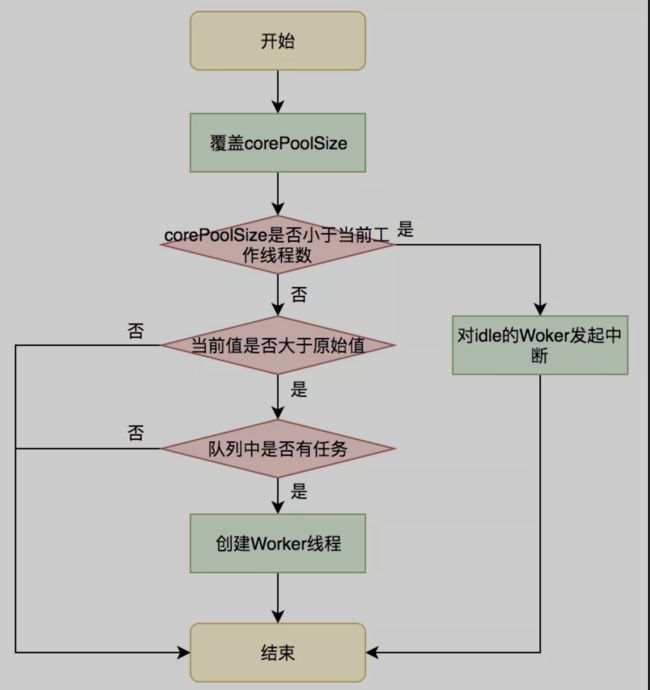Java-线程池动态修改大小
参数说明
corePoolSize:核心线程数大小,不管它们创建以后是不是空闲的。线程池需要保持 corePoolSize 数量的线程,除非设置了 allowCoreThreadTimeOut;
maximumPoolSize:最大线程数,线程池中最多允许创建 maximumPoolSize 个线程;
keepAliveTime:存活时间,如果经过 keepAliveTime 时间后,超过核心线程数的线程还没有接受到新的任务,那就回收;
unit: keepAliveTime 的时间单位;
workQueue:存放待执行任务的队列:当提交的任务数超过核心线程数大小后,再提交的任务就存放在这里。它仅仅用来存放被 execute 方法提交的 Runnable 任务;阻塞队列成员表:
threadFactory:线程工厂,用来创建线程工厂。比如这里面可以自定义线程名称,当进行虚拟机栈分析时,看着名字就知道这个线程是哪里来的,不会懵逼;
handler :拒绝策略:当队列里面放满了任务、最大线程数的线程都在工作时,这时继续提交的任务线程池就处理不了,应该执行怎么样的拒绝策略;
Executors - 线程池的工厂
SingleThreadExecutor
new ThreadPoolExecutor(1, 1,
0L, TimeUnit.MILLISECONDS,
new LinkedBlockingQueue<Runnable>())
为什么还有一个线程的线程池?
- 任务队列
- 生命周期管理
CachePool
new ThreadPoolExecutor(0, Integer.MAX_VALUE,
60L, TimeUnit.SECONDS,
new SynchronousQueue<Runnable>())
来一个任务执行一个任务,没有线程活着就新建一个线程
当任务数量忽高忽低时可以考虑
FixedThreadPool
new ThreadPoolExecutor(nThreads, nThreads,
0L, TimeUnit.MILLISECONDS,
new LinkedBlockingQueue<Runnable>());
线程数是固定的,线程不会被灭活
当任务量比较稳定,可以考虑
ScheduledThreadPool
public ScheduledThreadPoolExecutor(int corePoolSize) {
super(corePoolSize, Integer.MAX_VALUE, 0, NANOSECONDS,
new DelayedWorkQueue());
}
定时任务线程池
ForkJoinPool
WorkStealingPool
new ForkJoinPool
(Runtime.getRuntime().availableProcessors(),
ForkJoinPool.defaultForkJoinWorkerThreadFactory,
null, true);
每个线程有自己的一个任务队列,当自己任务队列完成了,可以从其他线程的队列拿一个任务出来执行
并发 vs并行
并发是指任务提交,并行指任务执行
并发是并行的子集
面试题:假如提供一个闹钟服务,订阅这个服务的人特别多,10亿人,怎么优化?
ThreadPoolExecutor源码解析
1、常用变量的解释
// 1. `ctl`,可以看做一个int类型的数字,高3位表示线程池状态,低29位表示worker数量
private final AtomicInteger ctl = new AtomicInteger(ctlOf(RUNNING, 0));
// 2. `COUNT_BITS`,`Integer.SIZE`为32,所以`COUNT_BITS`为29
private static final int COUNT_BITS = Integer.SIZE - 3;
// 3. `CAPACITY`,线程池允许的最大线程数。1左移29位,然后减1,即为 2^29 - 1
private static final int CAPACITY = (1 << COUNT_BITS) - 1;
// runState is stored in the high-order bits
// 4. 线程池有5种状态,按大小排序如下:RUNNING < SHUTDOWN < STOP < TIDYING < TERMINATED
private static final int RUNNING = -1 << COUNT_BITS;
private static final int SHUTDOWN = 0 << COUNT_BITS;
private static final int STOP = 1 << COUNT_BITS;
private static final int TIDYING = 2 << COUNT_BITS;
private static final int TERMINATED = 3 << COUNT_BITS;
// Packing and unpacking ctl
// 5. `runStateOf()`,获取线程池状态,通过按位与操作,低29位将全部变成0
private static int runStateOf(int c) { return c & ~CAPACITY; }
// 6. `workerCountOf()`,获取线程池worker数量,通过按位与操作,高3位将全部变成0
private static int workerCountOf(int c) { return c & CAPACITY; }
// 7. `ctlOf()`,根据线程池状态和线程池worker数量,生成ctl值
private static int ctlOf(int rs, int wc) { return rs | wc; }
/*
* Bit field accessors that don't require unpacking ctl.
* These depend on the bit layout and on workerCount being never negative.
*/
// 8. `runStateLessThan()`,线程池状态小于xx
private static boolean runStateLessThan(int c, int s) {
return c < s;
}
// 9. `runStateAtLeast()`,线程池状态大于等于xx
private static boolean runStateAtLeast(int c, int s) {
return c >= s;
}
2、构造方法
public ThreadPoolExecutor(int corePoolSize,
int maximumPoolSize,
long keepAliveTime,
TimeUnit unit,
BlockingQueue<Runnable> workQueue,
ThreadFactory threadFactory,
RejectedExecutionHandler handler) {
// 基本类型参数校验
if (corePoolSize < 0 ||
maximumPoolSize <= 0 ||
maximumPoolSize < corePoolSize ||
keepAliveTime < 0)
throw new IllegalArgumentException();
// 空指针校验
if (workQueue == null || threadFactory == null || handler == null)
throw new NullPointerException();
this.corePoolSize = corePoolSize;
this.maximumPoolSize = maximumPoolSize;
this.workQueue = workQueue;
// 根据传入参数`unit`和`keepAliveTime`,将存活时间转换为纳秒存到变量`keepAliveTime `中
this.keepAliveTime = unit.toNanos(keepAliveTime);
this.threadFactory = threadFactory;
this.handler = handler;
}
3、提交执行task的过程
public void execute(Runnable command) {
if (command == null)
throw new NullPointerException();
/*
* Proceed in 3 steps:
*
* 1. If fewer than corePoolSize threads are running, try to
* start a new thread with the given command as its first
* task. The call to addWorker atomically checks runState and
* workerCount, and so prevents false alarms that would add
* threads when it shouldn't, by returning false.
*
* 2. If a task can be successfully queued, then we still need
* to double-check whether we should have added a thread
* (because existing ones died since last checking) or that
* the pool shut down since entry into this method. So we
* recheck state and if necessary roll back the enqueuing if
* stopped, or start a new thread if there are none.
*
* 3. If we cannot queue task, then we try to add a new
* thread. If it fails, we know we are shut down or saturated
* and so reject the task.
*/
int c = ctl.get();
// worker数量比核心线程数小,直接创建worker执行任务
if (workerCountOf(c) < corePoolSize) {
if (addWorker(command, true))
return;
c = ctl.get();
}
// worker数量超过核心线程数,任务直接进入队列
if (isRunning(c) && workQueue.offer(command)) {
int recheck = ctl.get();
// 线程池状态不是RUNNING状态,说明执行过shutdown命令,需要对新加入的任务执行reject()操作。
// 这儿为什么需要recheck,是因为任务入队列前后,线程池的状态可能会发生变化。
if (! isRunning(recheck) && remove(command))
reject(command);
// 这儿为什么需要判断0值,主要是在线程池构造方法中,核心线程数允许为0
else if (workerCountOf(recheck) == 0)
addWorker(null, false);
}
// 如果线程池不是运行状态,或者任务进入队列失败,则尝试创建worker执行任务。
// 这儿有3点需要注意:
// 1. 线程池不是运行状态时,addWorker内部会判断线程池状态
// 2. addWorker第2个参数表示是否创建核心线程
// 3. addWorker返回false,则说明任务执行失败,需要执行reject操作
else if (!addWorker(command, false))
reject(command);
}
4、addworker源码解析
private boolean addWorker(Runnable firstTask, boolean core) {
retry:
// 外层自旋
for (;;) {
int c = ctl.get();
int rs = runStateOf(c);
// 这个条件写得比较难懂,我对其进行了调整,和下面的条件等价
// (rs > SHUTDOWN) ||
// (rs == SHUTDOWN && firstTask != null) ||
// (rs == SHUTDOWN && workQueue.isEmpty())
// 1. 线程池状态大于SHUTDOWN时,直接返回false
// 2. 线程池状态等于SHUTDOWN,且firstTask不为null,直接返回false
// 3. 线程池状态等于SHUTDOWN,且队列为空,直接返回false
// Check if queue empty only if necessary.
if (rs >= SHUTDOWN &&
! (rs == SHUTDOWN &&
firstTask == null &&
! workQueue.isEmpty()))
return false;
// 内层自旋
for (;;) {
int wc = workerCountOf(c);
// worker数量超过容量,直接返回false
if (wc >= CAPACITY ||
wc >= (core ? corePoolSize : maximumPoolSize))
return false;
// 使用CAS的方式增加worker数量。
// 若增加成功,则直接跳出外层循环进入到第二部分
if (compareAndIncrementWorkerCount(c))
break retry;
c = ctl.get(); // Re-read ctl
// 线程池状态发生变化,对外层循环进行自旋
if (runStateOf(c) != rs)
continue retry;
// 其他情况,直接内层循环进行自旋即可
// else CAS failed due to workerCount change; retry inner loop
}
}
boolean workerStarted = false;
boolean workerAdded = false;
Worker w = null;
try {
w = new Worker(firstTask);
final Thread t = w.thread;
if (t != null) {
final ReentrantLock mainLock = this.mainLock;
// worker的添加必须是串行的,因此需要加锁
mainLock.lock();
try {
// Recheck while holding lock.
// Back out on ThreadFactory failure or if
// shut down before lock acquired.
// 这儿需要重新检查线程池状态
int rs = runStateOf(ctl.get());
if (rs < SHUTDOWN ||
(rs == SHUTDOWN && firstTask == null)) {
// worker已经调用过了start()方法,则不再创建worker
if (t.isAlive()) // precheck that t is startable
throw new IllegalThreadStateException();
// worker创建并添加到workers成功
workers.add(w);
// 更新`largestPoolSize`变量
int s = workers.size();
if (s > largestPoolSize)
largestPoolSize = s;
workerAdded = true;
}
} finally {
mainLock.unlock();
}
// 启动worker线程
if (workerAdded) {
t.start();
workerStarted = true;
}
}
} finally {
// worker线程启动失败,说明线程池状态发生了变化(关闭操作被执行),需要进行shutdown相关操作
if (! workerStarted)
addWorkerFailed(w);
}
return workerStarted;
}
5、线程池worker任务单元
private final class Worker
extends AbstractQueuedSynchronizer
implements Runnable
{
/**
* This class will never be serialized, but we provide a
* serialVersionUID to suppress a javac warning.
*/
private static final long serialVersionUID = 6138294804551838833L;
/** Thread this worker is running in. Null if factory fails. */
final Thread thread;
/** Initial task to run. Possibly null. */
Runnable firstTask;
/** Per-thread task counter */
volatile long completedTasks;
/**
* Creates with given first task and thread from ThreadFactory.
* @param firstTask the first task (null if none)
*/
Worker(Runnable firstTask) {
setState(-1); // inhibit interrupts until runWorker
this.firstTask = firstTask;
// 这儿是Worker的关键所在,使用了线程工厂创建了一个线程。传入的参数为当前worker
this.thread = getThreadFactory().newThread(this);
}
/** Delegates main run loop to outer runWorker */
public void run() {
runWorker(this);
}
// 省略代码...
}
6、核心线程执行逻辑-runworker
final void runWorker(Worker w) {
Thread wt = Thread.currentThread();
Runnable task = w.firstTask;
w.firstTask = null;
// 调用unlock()是为了让外部可以中断
w.unlock(); // allow interrupts
// 这个变量用于判断是否进入过自旋(while循环)
boolean completedAbruptly = true;
try {
// 这儿是自旋
// 1. 如果firstTask不为null,则执行firstTask;
// 2. 如果firstTask为null,则调用getTask()从队列获取任务。
// 3. 阻塞队列的特性就是:当队列为空时,当前线程会被阻塞等待
while (task != null || (task = getTask()) != null) {
// 这儿对worker进行加锁,是为了达到下面的目的
// 1. 降低锁范围,提升性能
// 2. 保证每个worker执行的任务是串行的
w.lock();
// If pool is stopping, ensure thread is interrupted;
// if not, ensure thread is not interrupted. This
// requires a recheck in second case to deal with
// shutdownNow race while clearing interrupt
// 如果线程池正在停止,则对当前线程进行中断操作
if ((runStateAtLeast(ctl.get(), STOP) ||
(Thread.interrupted() &&
runStateAtLeast(ctl.get(), STOP))) &&
!wt.isInterrupted())
wt.interrupt();
// 执行任务,且在执行前后通过`beforeExecute()`和`afterExecute()`来扩展其功能。
// 这两个方法在当前类里面为空实现。
try {
beforeExecute(wt, task);
Throwable thrown = null;
try {
task.run();
} catch (RuntimeException x) {
thrown = x; throw x;
} catch (Error x) {
thrown = x; throw x;
} catch (Throwable x) {
thrown = x; throw new Error(x);
} finally {
afterExecute(task, thrown);
}
} finally {
// 帮助gc
task = null;
// 已完成任务数加一
w.completedTasks++;
w.unlock();
}
}
completedAbruptly = false;
} finally {
// 自旋操作被退出,说明线程池正在结束
processWorkerExit(w, completedAbruptly);
}
}
线程池参数动态化
现有的解决方案的痛点。
现在市面上大多数的答案都是先区分线程池中的任务是 IO 密集型还是 CPU 密集型。
但是往往一台服务器是部署了多个应用,一个应用也会有多个线程池,所以很难配置一个完美的参数
动态更新的工作原理是什么?
看ThreadPoolExecutor 的 setCorePoolSize 方法:
/**
* Sets the core number of threads. This overrides any value set
* in the constructor. If the new value is smaller than the
* current value, excess existing threads will be terminated when
* they next become idle. If larger, new threads will, if needed,
* be started to execute any queued tasks.
*
* @param corePoolSize the new core size
* @throws IllegalArgumentException if {@code corePoolSize < 0}
* @see #getCorePoolSize
*/
public void setCorePoolSize(int corePoolSize) {
if (corePoolSize < 0)
throw new IllegalArgumentException();
int delta = corePoolSize - this.corePoolSize;
this.corePoolSize = corePoolSize;
if (workerCountOf(ctl.get()) > corePoolSize)
interruptIdleWorkers();
else if (delta > 0) {
// We don't really know how many new threads are "needed".
// As a heuristic, prestart enough new workers (up to new
// core size) to handle the current number of tasks in
// queue, but stop if queue becomes empty while doing so.
int k = Math.min(delta, workQueue.size());
while (k-- > 0 && addWorker(null, true)) {
if (workQueue.isEmpty())
break;
}
}
}
在Spring 的 ThreadPoolTaskExecutor类 (就是对JDK ThreadPoolExecutor 的一层包装,可以理解为装饰者模式)的 setCorePoolSize 方法:
/**
* Set the ThreadPoolExecutor's core pool size.
* Default is 1.
* This setting can be modified at runtime, for example through JMX.
*/
public void setCorePoolSize(int corePoolSize) {
synchronized (this.poolSizeMonitor) {
this.corePoolSize = corePoolSize;
if (this.threadPoolExecutor != null) {
this.threadPoolExecutor.setCorePoolSize(corePoolSize);
}
}
}
看ThreadPoolExecutor的setMaximumPoolSize 源码:
/**
* Sets the maximum allowed number of threads. This overrides any
* value set in the constructor. If the new value is smaller than
* the current value, excess existing threads will be
* terminated when they next become idle.
*
* @param maximumPoolSize the new maximum
* @throws IllegalArgumentException if the new maximum is
* less than or equal to zero, or
* less than the {@linkplain #getCorePoolSize core pool size}
* @see #getMaximumPoolSize
*/
public void setMaximumPoolSize(int maximumPoolSize) {
if (maximumPoolSize <= 0 || maximumPoolSize < corePoolSize)
throw new IllegalArgumentException();
this.maximumPoolSize = maximumPoolSize;
if (workerCountOf(ctl.get()) > maximumPoolSize)
interruptIdleWorkers();
}
经过前面两个方法的分析,我们知道了最大线程数和核心线程数可以动态调整。
动态设置的注意点有哪些?
当只调整核心线程数,不调整最大线程数是,调整的时候可能会出现核心线程数调整之后无效的情况;
原因看源码:
/**
* Performs blocking or timed wait for a task, depending on
* current configuration settings, or returns null if this worker
* must exit because of any of:
* 1. There are more than maximumPoolSize workers (due to
* a call to setMaximumPoolSize).
* 2. The pool is stopped.
* 3. The pool is shutdown and the queue is empty.
* 4. This worker timed out waiting for a task, and timed-out
* workers are subject to termination (that is,
* {@code allowCoreThreadTimeOut || workerCount > corePoolSize})
* both before and after the timed wait, and if the queue is
* non-empty, this worker is not the last thread in the pool.
*
* @return task, or null if the worker must exit, in which case
* workerCount is decremented
*/
private Runnable getTask() {
boolean timedOut = false; // Did the last poll() time out?
for (;;) {
int c = ctl.get();
int rs = runStateOf(c);
// Check if queue empty only if necessary.
if (rs >= SHUTDOWN && (rs >= STOP || workQueue.isEmpty())) {
decrementWorkerCount();
return null;
}
int wc = workerCountOf(c);
// Are workers subject to culling?
boolean timed = allowCoreThreadTimeOut || wc > corePoolSize;
// 如果工作线程数大于最大线程数,则对工作线程数量进行减一操作,然后返回 null。
if ((wc > maximumPoolSize || (timed && timedOut))
&& (wc > 1 || workQueue.isEmpty())) {
//对工作线程数量进行减一操作
if (compareAndDecrementWorkerCount(c))
return null;
continue;
}
try {
Runnable r = timed ?
workQueue.poll(keepAliveTime, TimeUnit.NANOSECONDS) :
workQueue.take();
if (r != null)
return r;
timedOut = true;
} catch (InterruptedException retry) {
timedOut = false;
}
}
}
所以,这个地方的实际流程应该是:
-
创建新的工作线程 worker,然后工作线程数进行加一操作。
-
运行创建的工作线程 worker,开始获取任务 task。
-
工作线程数量大于最大线程数,对工作线程数进行减一操作。
-
返回 null,即没有获取到 task。
-
清理该任务,流程结束。
这样一加一减,所以真正在执行任务的工作线程数的数量一直没有发生变化,也就是最大线程数。
**解决方法:**设置核心线程数的时候,同时设置最大线程数即可。其实可以把二者设置为相同的值,然后设置allowCoreThreadTimeOut 参数设置为 true ,核心线程在空闲了 keepAliveTime 的时间后也会被回收的,相当于线程池自动给你动态修改。
如何动态指定队列长度?
/** The capacity bound, or Integer.MAX_VALUE if none */
private final int capacity;
因为LinkedBlockingQueue的capacity是被final修饰的,所以是不允许动态修改的;
所以要想动态修改只能自己实现一个BlockingQueue,然后capacity可以动态修改即可;复制一个LinkedBlockingQueue源码,将capacity的final修饰去掉,添加set方法,保存为ResizableCapacityLinkedBlockingQueue.java即可,然后使用ResizableCapacityLinkedBlockingQueue作为任务队列;
这个过程中涉及到的面试题有哪些?
问题一:线程池被创建后里面有线程吗?如果没有的话,你知道有什么方法对线程池进行预热吗?
答:线程池被创建后如果没有任务过来,里面是不会有线程的。如果需要预热的话可以调用下面的两个方法:
prestartCoreThread()和prestartAllCoreThreads()
问题二:核心线程数会被回收吗?需要什么设置?
答:核心线程数默认是不会被回收的,如果需要回收核心线程数,需要调用下面的方法:allowCoreThreadTimeOut();





